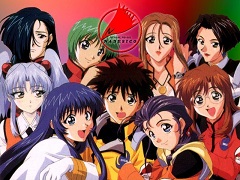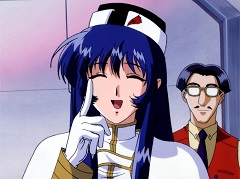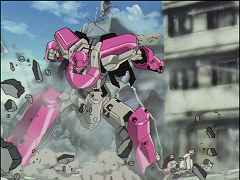 \\
\\Martian Successor Nadesico
After Evangelion came along, it really changed the tone as to how televised anime could be done. Prior to its airing, there was a clear divide between TV and OVA. The stuff airing on television was either a vehicle for selling toys to kids or some sort of reasonably mainstream, easily relatable theme like sports anime or slice of life. Meanwhile, OVAs were largely the realm of more mature / gory / spicy content that would never be allowed to air on TV. When Eva aired, it showed the industry that the public had a taste for more challenging content in televised anime. As a result, there was an explosion of shows trying new things and going in directions that would never have happened on TV, and if they happened at all would have only appeared on OVAs previously.This is where Martian Successor Nadesico comes in. It’s one of the first major series to broadcast in the wake of Evangelion, and one could argue that it was the thin edge of the wedge in this new wave of anime trying new things. The show was a parody / deconstruction of the mecha genre. Given the nature of the show, there’s an argument to be made that it could just as well have been televised prior to Eva, but one has to wonder if TV execs would have been reluctant given all the deconstruction undertones in the show. A lot of higher ups in television tend to err on the side of viewers being dumb, and may well have advised that Nadesico be an OVA instead had it come along a few years earlier. As it stands, the show feels like the industry’s first tentative steps to move en masse in a slightly more challenging direction in the wake of Evangelion. This isn't to say the show is bottomless pit of deep insight. That would be giving it way too much credit. Effort was made nonetheless, and Nadesico attempted to get viewers thinking about the nature of a genre over 26 episodes. This is something people didn't come across often in the mid to late 90s.
The show follows the crew of a new, ultra high tech space faring battleship called the Nadesico. It takes place well into the future when humans have colonized the moon and Mars. However, they have begun to be attacked by an alien fleet simply referred to as the Jovian lizard men, who supposedly come from Jupiter. A young lad named Akito is one member of this crew, and a survivor of a major Jovian attack on Mars. It’s here that he’s unexpectedly joined by his childhood friend Yurika, who is the captain of the ship. She’s an unexpected choice. Despite finishing at the top of her class, she’s still inexperienced, uncharacteristically carefree for a captain, and seems more concerned with professing her love for Akito than actually doing her job.
It isn’t long before viewers are introduced to the rest of the crew, the vast majority of whom are female. With that, Nadesico drifts toward being a bit of a harem as well with a number of the girls on the ship falling for Akito as the show progresses. One nice thing about this is that Akito has a better head on his shoulders than a lot of modern male leads in a harem would, as he actually is able to put two and two together. As such, he goes on the occasional date with some of these ladies and even has a girlfriend for a bit. It’s a nice change of pace from the unyielding cluelessness so common in modern harems.
Core characters get fleshed out decently over the show. Most screen time is directed at Akito where he goes from being extremely tense and not wanting to fight in a war to borderline-competent mecha pilot. He never actually gets good at it. The show isn’t that cliched, but he comes to terms with his past enough to not be a total liability to the other pilots in his squad. While Yurika comes off as being in way over her head, she actually does a decent job as captain and has to make some tough decisions. Much of the supporting cast fill anime archetypes but a few get an episode or two dedicated to them, building a back story or otherwise adding some depth to them. Nadesico doesn’t go deep with its character development but it goes far enough for viewers to have a strong connection to the ship’s crew.
Meanwhile, the parody / deconstruction marches steadily along throughout the show. It pokes fun at senseless deaths in the name of sacrifice, hot-blooded young male leads, corporatism, and a number of other themes. It particularly likes having a laugh at older mecha shows from the 1970s and the way they would carry themselves. In fact, around halfway through the series, there’s a major reveal that makes excellent use of this in a way never seen before or since. It’s actually quite clever.
Nadesico was actually created as an anime first, and had a manga adaptation later. It was written by Shou Aikawa who had largely worked adapting manga into anime up to that point and would continue to do so after. Some of these projects included the anime versions of Urotsukidoji, Love Hina, and Full Metal Alchemist (the first run, not Brotherhood). The show was also the first series directed by Tatsuo Satou, who has done a few other series since then including Shigofumi: Letters from the Departed and Bodacious Space Pirates. The Japanese voice actors would go on to do countless other anime in subsequent years, but it may be of particular interest to note the video games they were involved with. Akito’s VA, Yuuji Ueda, has been the voice of Blanka in the last few Street Fighters. Meanwhile, Yurika’s actor, Houka Kuwashima, would become the voice of Seong-Mina in Soul Calibur as well as Kasami in the Dead or Alive series.
Art direction is typical of what one would expect in an anime that came out in the latter half of the 1990s. Character design is in line with what was popular during that period. Each character has their own style that may or may not coincide with their personality archetype. Meanwhile, the mechas look quite mech-like. This isn’t meant to be a flippant statements, it’s just that they aren’t a major focus of the show. Yes, Akito pilots one, but they’re tools in battle and combat focuses more on overall strategies. Fights are also over quickly. There isn’t much reason to focus on these machines because while Nadesico is poking fun at the mecha genre it does so largely through the actual characters. The only time it parodies giant robots and said robots are in sharp focus is when it comes to how it portrays the old retro robots of the 70s, and again it’s more about the archaic, hyper-idealistic attitudes of the characters in those shows. So, artistically, the show looks fine. It definitely doesn’t come off as cheap or low quality, but it also would be a tough sell to say that it reinvented the wheel visually.
One disappointment that is important to note before wrapping up is that the ending isn't very satisfying. Things kind of get closure in terms of immediate events more or less getting sorted out. However, there's still a war going on, and people whose fates are in limbo. Nadesico would go on via a couple of dating sims on the Sega Saturn, and a movie that takes place three years later and stars Ruri, who was in charge of maintaining the ship's computer. Even with these, the story never wraps up properly. There's always this taste left in one's mouth that the ending needed a lot more work.
People looking for a mecha parody / deconstruction that has a good balance of laughs and poignancy would do well to take Martian Successor Nadesico for a spin. The characters are quite likeable, and it casts the genre in an interesting light. The twist halfway through is really good. Most people won’t see it coming. Just be prepared for a lackluster conclusion to the series.
- IroIro
March 29, 2019
Directed by: Tatsuo Satou
Studio: Xebec
Released: 1996/7
Episodes: 26

DVD Cover Art

There are a lot of women in Nadesico

Yurika is a very cheerful captain

Ryoko and friends are easily the most talented mecha pilots

An Aestivalis Battle Frame, the primary mecha of Nadesico